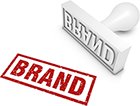3.2 Defining what a brand is
The word ‘brand’ originates from the old Norse word brandr meaning ‘to burn’. It referred to the mark that cowboys would burn into their livestock’s skin to identify the owner (Keller, 2008).

The term ‘brand’ was transferred and applied to business brands and is now widely used in business jargon. The American Marketing Association (AMA, 2012) defines a brand as a:
Name, term, design, symbol, or any other feature that identifies one seller's good or service as distinct from those of other sellers. The legal term for brand is trademark. A brand may identify one item, a family of items or all items of that seller. If used for the organisation as a whole, the preferred term is trade name.
The AMA brand definition highlights the idea of identifying the product and making it distinctive. It also suggests the different levels of application of brands: single items, family of items or even the organisation. We will consider this idea later in the course when we address brand hierarchy.
In principle, a brand is created when a marketer attaches a name or symbol to a product (Keller, 2008). Yet, in practice, and from a managerial point of view, brand management is much broader.
Brand management entails forming core bridges with the marketplace around awareness, image and reputation. Consequently, the term ‘brand’ also considers aspects related to the marketplace and customers’ perception of the brand. To capture this idea, the AMA (2012) considers the term ‘brand’ with a capital ‘B’ to define Brand and Branding:
A brand is a customer experience represented by a collection of images and ideas; often, it refers to a symbol such as a name, logo, slogan, and design scheme. Brand recognition and other reactions are created by the accumulation of experiences with the specific product or service, both directly relating to its use, and through the influence of advertising, design, and media commentary. A brand often includes an explicit logo, fonts, color schemes, symbols, sound which may be developed to represent implicit values, ideas, and even personality.
The AMA brand descriptions are evident in virtually all the brands to which we are exposed. Yet some brands are more appealing to us than others. Why?
The answer is complex, as we will discover throughout this course. For example, the car manufacturer BMW has its own YouTube channel showing its executives discussing how they translate the BMW brand into car designs and marketing communications to create an emotional link between the brand and consumer.
We can understand this brand relationship further through this video clip that discusses how emotions and experience are connected to the BMW brand features of efficiency and reliability.
The BMW Brand - Emotions [Tip: hold Ctrl and click a link to open it in a new tab. (Hide tip)]
We can illustrate how BMW communicates its brand offering in this BMW 3 series advertisement.

You may notice that the brand facets of innovativeness, reliability and consumer experience are reflected in the advertisement. The underlying idea behind the BMW 3 series is to convey sportiness and passion coupled with efficiency and impressive design.
In this example, the BMW brand helps managers to define their business and product offering, allowing them to connect with the market. Brands are not only relevant to organisations but they also help consumers make product choices. By looking at the BMW 3 Series advertisement the consumer expects a reliable and sporty car.
Stop and reflect
- Why do brands exist?
- Why are they important?
Think about your organisation and the brand(s) it sells. You may think that its brand(s) allow(s) your organisation to focus on higher quality standards and differentiate from cheaper offers in the market. You may also consider the extent to which the brand(s) is(are) relevant to conveying an image of quality to customers.
Alternatively, think of yourself as a brand consumer. Reflect on what makes you choose one brand instead of another. You may drive a particular car brand or wear certain branded clothes because they make you feel secure and important. You may also consider how often you tend to buy the same brand. Such brand repetition shows your loyalty towards a particular brand.
In the next three sections you will learn more about the benefits of brands to organisations and consumers. This will allow you to understand better the different roles that brands may have for businesses and customers.
